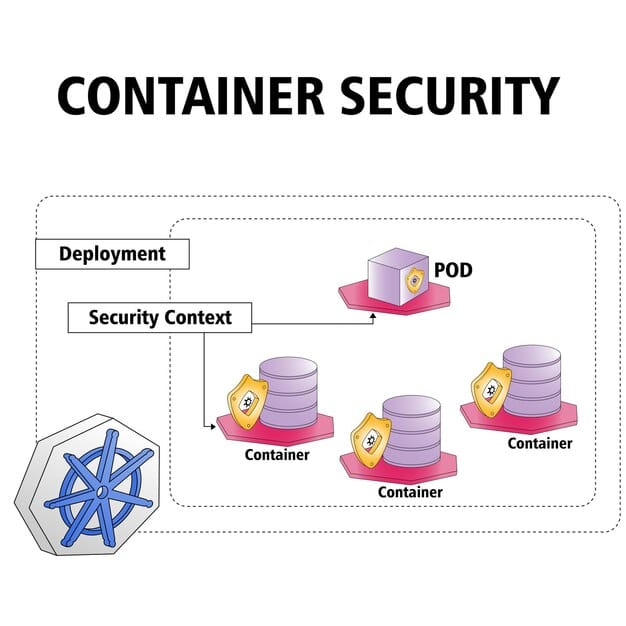API Security: Best Practices for Protecting Your Fintech Platform

API security best practices are crucial for protecting fintech platforms from data breaches, ensuring the confidentiality, integrity, and availability of sensitive financial data and maintaining customer trust.
In the fast-evolving world of fintech, Application Programming Interfaces (APIs) have become essential for connecting services and exchanging data. However, this interconnectedness also introduces significant security risks. Implementing robust API security best practices: Protecting Your Fintech Platform from Data Breaches is paramount to safeguarding sensitive financial data and maintaining customer trust.
Understanding API Security in Fintech
APIs in fintech are the backbone of many innovative services, enabling seamless transactions, data sharing, and integration with third-party applications. However, they also present a significant attack surface if not properly secured. A single vulnerability in an API can expose vast amounts of sensitive data, leading to financial losses and reputational damage.
Why API Security is Critical for Fintech
The fintech industry handles highly sensitive information, including financial transactions, customer data, and proprietary algorithms. This makes it a prime target for cyberattacks. Strong API security measures are crucial to protect against various threats, such as data breaches, fraud, and denial-of-service attacks.
- Data Protection: APIs must protect sensitive data from unauthorized access and manipulation.
- Compliance: Fintech companies are subject to strict regulatory requirements, such as PCI DSS and GDPR, which mandate strong security measures for APIs.
- Trust: Maintaining customer trust is essential for the success of any fintech business, and a data breach can severely damage this trust.
Common API Security Threats in Fintech
Understanding the specific threats that APIs face in the fintech industry is the first step towards implementing effective security measures. Some common threats include:
- Injection Attacks: Attackers can inject malicious code into API requests to gain unauthorized access to data or systems.
- Broken Authentication: Weak authentication mechanisms can allow attackers to impersonate legitimate users and access sensitive data.
- Data Exposure: APIs may inadvertently expose sensitive data in responses, leading to data breaches.
- Denial of Service (DoS): Attackers can flood APIs with requests to overwhelm the system and make it unavailable to legitimate users.
In conclusion, API security is not just a technical requirement but a fundamental business imperative for fintech companies. By understanding the risks and implementing robust security measures, fintech businesses can protect their data, comply with regulations, and maintain customer trust.

Best Practices for API Authentication and Authorization
Authentication and authorization are the cornerstones of API security. Authentication verifies the identity of the user or application making the API request, while authorization determines what resources they are allowed to access. Implementing robust authentication and authorization mechanisms is crucial to prevent unauthorized access to sensitive data.
Implementing Strong Authentication Mechanisms
Choosing the right authentication method is critical. Common options include:
- OAuth 2.0: An industry-standard protocol for delegated authorization, allowing users to grant limited access to their data without sharing their credentials.
- API Keys: Unique identifiers assigned to each application using the API, allowing the API to track and control access.
- JSON Web Tokens (JWT): A compact and self-contained way to securely transmit information between parties as a JSON object.
Best Practices for Authorization
Authorization ensures that authenticated users or applications only have access to the resources they are authorized to use. Implementing proper authorization controls is essential to prevent privilege escalation and data breaches.
- Role-Based Access Control (RBAC): Assigning users or applications to specific roles and granting access based on those roles.
- Attribute-Based Access Control (ABAC): Granting access based on a combination of attributes, such as user attributes, resource attributes, and environmental attributes.
- Least Privilege Principle: Granting users or applications only the minimum level of access required to perform their tasks.
Securing API Keys and Credentials
API keys and other credentials must be stored and managed securely to prevent unauthorized access. Best practices include:
- Encryption: Encrypting API keys and other credentials at rest and in transit.
- Rotation: Regularly rotating API keys and other credentials to limit the impact of a potential compromise.
- Secure Storage: Storing API keys and other credentials in a secure vault or hardware security module (HSM).
Implementing strong authentication and authorization mechanisms is crucial for protecting APIs from unauthorized access. By using industry-standard protocols, enforcing the principle of least privilege, and securely managing credentials, fintech companies can significantly reduce their risk of data breaches.
Data Encryption and Secure Communication
Protecting data in transit and at rest is a fundamental aspect of API security. Encryption ensures that data is unreadable to unauthorized parties, while secure communication protocols protect data from eavesdropping and tampering. Implementing robust encryption and secure communication measures is essential for maintaining the confidentiality and integrity of sensitive financial data.
Encrypting Data in Transit
Data transmitted over APIs should be encrypted using Transport Layer Security (TLS) or Secure Sockets Layer (SSL) protocols. These protocols establish a secure connection between the client and the server, protecting data from eavesdropping and tampering.
Encrypting Data at Rest
Data stored on servers and databases should be encrypted using strong encryption algorithms. This protects data from unauthorized access in the event of a data breach or security incident.
Using HTTPS for API Communication
HTTPS (HTTP Secure) is the secure version of HTTP, the protocol used for communication between web browsers and servers. APIs should always be accessed over HTTPS to ensure that data is encrypted in transit.
Implementing Key Management Practices
Managing encryption keys is a critical aspect of data protection. Best practices include:
- Key Rotation: Regularly rotating encryption keys to limit the impact of a potential compromise.
- Secure Storage: Storing encryption keys in a secure vault or hardware security module (HSM).
- Access Control: Restricting access to encryption keys to authorized personnel only.
Data encryption and secure communication are essential for protecting sensitive financial data from unauthorized access. By using strong encryption algorithms, implementing secure communication protocols, and managing encryption keys properly, fintech companies can significantly reduce their risk of data breaches.

Input Validation and Output Encoding
Input validation and output encoding are essential for preventing injection attacks and data exposure. Input validation ensures that data received by the API is valid and safe to process, while output encoding protects against cross-site scripting (XSS) and other vulnerabilities.
Validating API Inputs
All data received by the API should be validated to ensure that it meets the expected format, length, and type. This can help prevent injection attacks, such as SQL injection and command injection.
Encoding API Outputs
Data returned by the API should be encoded to prevent cross-site scripting (XSS) and other vulnerabilities. Encoding converts characters that have special meaning in HTML or other markup languages into their equivalent entities.
Preventing Injection Attacks
Injection attacks occur when attackers inject malicious code into API requests to gain unauthorized access to data or systems. Input validation and output encoding are essential for preventing these attacks.
Handling Errors Gracefully
APIs should handle errors gracefully and provide informative error messages to clients. However, error messages should not reveal sensitive information about the system or data.
Input validation and output encoding are essential for protecting APIs from injection attacks and data exposure. By validating API inputs, encoding API outputs, and handling errors gracefully, fintech companies can significantly reduce their risk of security vulnerabilities.
API Monitoring and Logging
Monitoring and logging are essential for detecting and responding to security incidents. API monitoring involves tracking API traffic and performance to identify anomalies and potential attacks, while logging involves recording API requests and responses for auditing and analysis.
Implementing API Monitoring Tools
API monitoring tools can help you track API traffic, performance, and security events. These tools can provideReal-time alerts for suspicious activity and help you identify and respond to security incidents quickly.
Logging API Requests and Responses
Logging API requests and responses can provide valuable information for auditing and analysis. Logs can help you identify security vulnerabilities, track user activity, and investigate security incidents.
Analyzing API Logs for Security Threats
API logs should be analyzed regularly to identify potential security threats. This can help you detect and respond to attacks before they cause significant damage.
Setting Up Alerts for Suspicious Activity
Alerts should be set up for suspicious activity, such as unusual traffic patterns, failed authentication attempts, and unauthorized access attempts. This can help you detect and respond to attacks quickly.
API monitoring and logging are essential for detecting and responding to security incidents. By implementing API monitoring tools, logging API requests and responses, analyzing API logs for security threats, and setting up alerts for suspicious activity, fintech companies can significantly improve their security posture.
Rate Limiting and Throttling
Rate limiting and throttling are essential for preventing denial-of-service (DoS) attacks and protecting API resources from abuse. Rate limiting restricts the number of requests that a user or application can make to an API within a given time period, while throttling reduces the rate at which requests are processed.
Implementing Rate Limiting Policies
Rate limiting policies should be implemented to restrict the number of requests that a user or application can make to an API within a given time period. This can help prevent denial-of-service (DoS) attacks and protect API resources from abuse.
Using Throttling to Protect API Resources
Throttling can be used to reduce the rate at which requests are processed, preventing API resources from being overwhelmed by excessive traffic.
Configuring API Gateways for Rate Limiting and Throttling
API gateways can be configured to enforce rate limiting and throttling policies. This can help protect APIs from abuse and ensure that they remain available to legitimate users.
Monitoring API Usage and Adjusting Limits
API usage should be monitored regularly to identify potential abuse and adjust rate limiting and throttling policies accordingly.
Rate limiting and throttling are essential for preventing denial-of-service (DoS) attacks and protecting API resources from abuse. By implementing rate limiting policies, using throttling, configuring API gateways, and monitoring API usage, fintech companies can ensure that their APIs remain available to legitimate users.
Regular Security Audits and Penetration Testing
Regular security audits and penetration testing are essential for identifying and addressing security vulnerabilities in APIs. Security audits involve a comprehensive review of API security controls, while penetration testing involves simulating real-world attacks to identify vulnerabilities.
Conducting Regular Security Audits
Security audits should be conducted regularly to review API security controls and identify potential weaknesses. Audits should cover all aspects of API security, including authentication, authorization, data encryption, and input validation.
Performing Penetration Testing
Penetration testing involves simulating real-world attacks to identify vulnerabilities in APIs. Penetration tests should be performed by experienced security professionals who can identify and exploit vulnerabilities.
Addressing Identified Vulnerabilities
Any vulnerabilities identified during security audits or penetration testing should be addressed promptly. This may involve patching code, updating security configurations, or implementing new security controls.
Staying Up-to-Date with Security Best Practices
API security is an evolving field, and it’s important to stay up-to-date with the latest security best practices. This may involve attending security conferences, reading security blogs, and participating in security communities.
Regular security audits and penetration testing are essential for identifying and addressing security vulnerabilities in APIs. By conducting regular audits, performing penetration testing, addressing identified vulnerabilities, and staying up-to-date with security best practices, fintech companies can significantly improve their API security posture.
| Key Aspect | Brief Description |
|---|---|
| 🔑 Authentication | Verifying user identity with OAuth 2.0, API Keys, or JWT. |
| 🔒 Data Encryption | Protecting data in transit and at rest using strong encryption. |
| 🛡️ Input Validation | Ensuring data integrity to prevent injection attacks. |
| 🚦 Rate Limiting | Restricting API requests to prevent abuse and DDoS attacks. |
Frequently Asked Questions (FAQ)
▼
API security refers to the measures taken to protect APIs from unauthorized access, misuse, and attacks. It’s crucial in fintech because APIs handle sensitive financial data, and a breach can lead to significant financial and reputational damage.
▼
Some common threats include injection attacks (SQL, command), broken authentication, data exposure, denial-of-service (DoS) attacks, and cross-site scripting (XSS). These threats exploit vulnerabilities in API design and implementation.
▼
Use industry-standard protocols like OAuth 2.0, API keys, or JSON Web Tokens (JWT). Enforce strong password policies, implement multi-factor authentication, and regularly rotate API keys to enhance security.
▼
Rate limiting is a technique to restrict the number of requests a user can make within a specific time frame. It prevents abuse, denial-of-service attacks, and ensures fair usage of API resources, improving overall stability.
▼
Security audits and penetration testing should be conducted regularly, ideally at least once a year, or more frequently if significant changes are made to the API or if new vulnerabilities are discovered. Continuous monitoring is also essential.
Conclusion
In conclusion, securing APIs is of paramount importance for fintech platforms to protect sensitive data, maintain customer trust, and comply with regulatory requirements. By implementing the API security best practices: Protecting Your Fintech Platform from Data Breaches outlined above, fintech companies can significantly reduce their risk of data breaches and other security incidents, ensuring a more secure and reliable environment for their customers and stakeholders.





